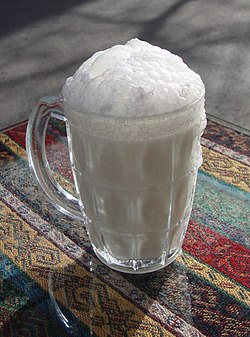Doogh
 Fresh Susurluk Ayranı with a head of froth | |
| Alternative names | Tan, Laban, Katık, Qeshk |
|---|---|
| Type | Dairy product |
| Course | Beverage |
| Serving temperature | Cold |
| Main ingredients | Yogurt, water |
| 410 kcal/l [1] kcal | |
Ayran is a cold yogurt beverage mixed with salt.[2] In addition to Turkey, where it is considered a national drink, ayran is found in Armenia (here called tan), Azerbaijan, Iran, the Balkans, Kazakhstan, Kyrgyzstan, Lebanon, Syria, Cyprus and across the Caucasus.[3] [4] Its primary ingredients are water and yogurt, and ayran has been variously described as "a most refreshing drink made by mixing yogurt with iced water"[5] and "diluted yogurt".[6]
Ayran is served chilled and often as an accompaniment to grilled meat or rice,[7] especially during summer.[8] It is an acquired taste for Westerners due to its salty taste distinct from sugary beverages widespread in Europe and North America.
Similar beverages include the Iranian doogh,[9] but yogurt drinks are popular beyond the Middle East region—ayran has been likened by some to the South Asian lassi.[10]
History
Although less popular today,[citation needed] another traditional Turkish dairy beverage is fermented mare's milk, kumis.[6]
Contemporary ayran
Ayran is ubiquitous in Turkey and offered at almost all places that serve drinks, including fast-food restaurants, such as McDonald's and Burger King.[11]
The town of Susurluk is well known in Turkey for its ayran, which characteristically has a foamy head and creamy taste.[12][13]
-
McDonald's ayran
Etymology
Some Turkish language dictionaries state the word ayran derives from Old Turkish for buttermilk.[14]
See also
Similar beverages
- Cacık
- Chal
- Chalap
- Doogh
- Kefir
- Lassi
- Leben
- Qatiq
- Yryan/Iryan - cossaks' version derivative from aryan
References
- ^ http://www.kalorisepeti.com/kac_kalori.php?yid=1361&kalorisi=Sütaş%20Tam%20Yağlı%20Ayran
- ^ A. Y. Tamime (ed.) (2008). Fermented Milks. John Wiley & Sons. p. 124. ISBN 9781405172387.
{{cite book}}:|author=has generic name (help) - ^ For popularity in Armenia, Azerbaijan, Kazakhstan, and Kyrgyzstan see Yildiz Fatih (2010). Development and Manufacture of Yogurt and Other Functional Dairy Products. CRC Press. p. 10. ISBN 9781420082081.
For the Balkans, see Leslie Strnadel, Patrick Erdley (2012). Bulgaria (Other Places Travel Guide). Other Places Publishing. p. 58. ISBN 9780982261996.
- For use in Afghanistan by Kirghiz, see Nazif Shahrani, M. (2013). The Kirghiz and Wakhi of Afghanistan. 9780295803784: University of Washington Press. pp. 92–93.
{{cite book}}: CS1 maint: location (link) - For Lebanon, see A. Y. Tamime (ed.) (2008). Fermented Milks. John Wiley & Sons. p. 96. ISBN 9781405172387.
{{cite book}}:|author=has generic name (help) - For presence in the North Caucasus, see Smih, Sebastian (2006). Allah's Mountains: The Battle for Chechnya. Tauris Parke Paperbacks. p. 25. ISBN 9781850439790.
- For use in Afghanistan by Kirghiz, see Nazif Shahrani, M. (2013). The Kirghiz and Wakhi of Afghanistan. 9780295803784: University of Washington Press. pp. 92–93.
- ^ "Development and Manufacture of Yogurt and Other Functional Dairy Products". Retrieved 25 November 2014.
- ^ Lake Van and Turkish Kurdistan: A Botanical Journey P. H. Davis The Geographical Journal, Vol. 122, No. 2 (Jun., 1956), pp. 156-165 Published by: The Royal Geographical Society (with the Institute of British Geographers) Article DOI: 10.2307/1790844
- ^ a b Cite error: The named reference
jstorwas invoked but never defined (see the help page). - ^ "Turkish Buttermilk". www.kultur.gov.tr. Ministry of Culture and Tourism, Turkey. Retrieved 5 October 2013.
- ^ Gina Husamettin. "Ayran – Turkish national beverage". balkon3.com. Retrieved 5 October 2013.
- ^ Yildiz Fatih (2010). Development and Manufacture of Yogurt and Other Functional Dairy Products. CRC Press. p. 10. ISBN 9781420082081.
- ^ Heyhoe, Kate. The ABC's of Larousse Gastronomique : ayran
- ^ For ayran at Turkish McDonalds, see "İçecekler: Ayran (250 ml)". McDonalds Turkey. Anadolu Restoran İşletmeleri Ltd. Şti. Retrieved 6 August 2013.
- For ayran at Turkish Burger King, see "İçim Ayran - Burger King Sultan Menü". Burger King Turkey. Retrieved 6 August 2013.
- ^ "Fame of foamy ayran goes beyond borders". Hürriyet Daily News. Hürriyet - Doğan Yayın Holding. Retrieved 7 January 2014.
- ^ "City Guide > Balıkesir > Don't Leave Without". kultur.gov.tr. Ministry of Culture and Tourism, Turkey. Retrieved 5 October 2013.
- ^ "Ayran". EtimolojiTurkce.com. Tehlif Hakları. Retrieved 31 August 2014.

